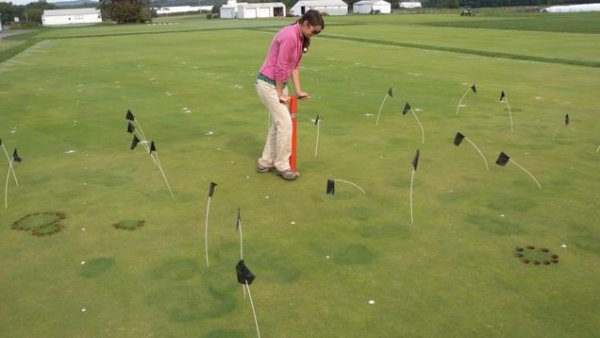EMS undergrads research energy, explore regions of Europe through science course
| psu.edu
A group of earth and mineral sciences undergraduates explored several regions of Europe through a science course to research energy and learn about different cultures.
Déjà vu all over again: Research shows 'mulch fungus' causes turfgrass disease
| psu.edu
An emerging turfgrass disease that is affecting golf courses around the world has been traced to a fungus commonly found in mulches. This is the first step toward a possible treatment for the disease.
Promotions in academic rank, effective July 1, 2015
| psu.edu
Following is a list of academic promotions for tenured and tenure-line faculty at Penn State, effective July 1.
State-of-the-art carbon-14 dating facility coming to Penn State
| psu.edu
Penn State will soon be home to an accelerator mass spectrometer (AMS) that will allow researchers all over the country to do high-precision carbon dating to address questions about Earth's past and present. The new instrument will be able to determine the age of samples from the past 10,000 years within 15 to 20 years and will be used by scientists from across the nation.
NASA awards $30M grant to Penn State to help answer climate questions
| psu.edu
Penn State will lead a five-year, $30 million mission to improve quantification of present-day carbon-related greenhouse gas sources and sinks. An improved understanding of these gases will advance our ability to predict and manage future climate change.
Data Commons connects researchers through data sharing
| psu.edu
In order to promote open access to research data, many funding agencies such as the National Science Foundation (NSF) and the National Institutes of Health (NIH), require that research data generated by publicly-funded projects be made publicly available. In addition, some journals require authors to make materials, data and associated protocols promptly available to readers as a condition of publication. Researchers can now more easily comply with these policies by utilizing the services of Penn State’s Data Commons.
Researchers study how to accurately measure a city's greenhouse gas emissions
| phys.org
If a community wanted to cut its greenhouse gas emissions and decided to take steps to do it, how would it know if the steps it was taking worked?
'Citizen science' leads to new Pa. birding atlas
| psu.edu
With the dedication of more than 2,000 volunteers, 52 authors and a number of trained ornithologists, geographic information specialists and other professionals, the Second Atlas of Breeding Birds in Pennsylvania was published in November by the Penn State University Press.
Ailanthus tree's status as invasive species offers lesson in human interaction
| psu.edu
An exotic tree species that changed from prized possession to forest management nightmare serves as a lesson in the unpredictability of non-native species mixing with human interactions, according to researchers.
Decoys could blunt spread of ash-killing beetles
| psu.edu
As the emerald ash borer ravages North American ash trees, threatening the trees' very survival, a team of entomologists and engineers may have found a way to prevent the spread of the pests. "Within 25 years, practically no ash trees may remain on either side of the St. Lawrence Seaway," said Akhlesh Lakhtakia, Charles Godfrey Binder Professor of Engineering Science and Mechanics at Penn State.
Science Seminars: Jan. 21 to 27
| psu.edu
Science Seminars for Jan 21 to 27











